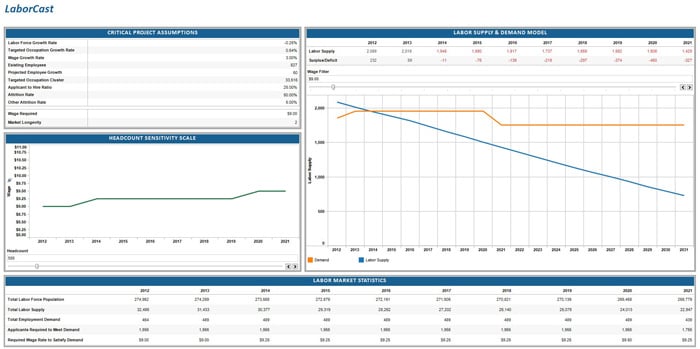Forecasting Labor Supply and Demand
by King White, on May 14, 2014 1:17:00 PM
Future labor conditions can greatly impact employee-intensive operations. Thus it’s imperative that companies considering expansions of existing operations or new facilities go beyond traditional demographic research when locating employee-intensive operations such as call centers, distribution centers, manufacturing plants, and shared service centers. Traditional demographic research can lead to short-sighted decisions. Site Selection Group identified three core factors that companies should evaluate when determining the longevity of labor markets: demographic shifts, skills gap, and labor competition.
Demographic Shifts
The United States is experiencing a significant shift in demographic conditions. Two key shifts will impact a labor market’s sustainability – population growth and the aging population. According to a study by Stanford Center for Longevity, the U.S. population is projected to grow by 91 million over the next 40 years, from 309 million in 2010 to 400 million in 2050. As a result, the working-age population, aged 20-64, will continue to increase; however, growth in this segment will be much slower than when it was fueled by baby boomers. This population segment will shrink as a share of the total population, from 60% in 2010 to 55% in 2050. By 2020, older workers age 55+ will account for 25% of the U.S. labor force, up from just 13% in 2000. As a result, it is critical to evaluate future demographics, not current, to identify the long-term demographic trends of a specific labor market.
Skills Gap
Employers will face a major battle in the future due to the current and projected skills gap in the United States. An estimated 4 million job openings will go unfilled while almost 10 million people are unemployed, according to Labor Department statistics. With technology accelerating the pace of change in the U.S. economy, the nation’s long-term competitiveness will be tied to the ability to produce a workforce with in-demand skills. To successfully address this challenge, businesses, training organizations, academic institutions, and the public sector must work together to prepare for the future needs of the labor market. Therefore, when evaluating locations, companies should understand how to utilize education systems and training programs to prepare their workers for the future.
Labor Market Competition
Labor markets are tightening as corporations expand across the U.S. As a result, competition for qualified labor is becoming more challenging every day. Whether you are looking for a production worker or a call center agent, the quality of the applicant pool is diminishing quickly while wage pressure is increasing. Companies are often forced to hire workers who they fired the previous year. To measure labor market competition, it is critical to evaluate the future labor market demand from competing employers against the projected supply of qualified labor before making an expansion decision. Until recently, there have not been any tools to help companies forecast future labor conditions. Site Selection Group developed a forecasting tool, called LaborCastTM, to determine labor market longevity based on future labor supply and demand. The following analysis provides an example of how labor market longevity can be measured:

Conclusions
The ability to forecast future labor conditions may seem impossible but in the age of “Big Data,” it has become possible to perform these types of advanced labor analytics. These analytics will become the norm in making corporate location decisions in the future so it is critical that companies utilize these tools to stay ahead of competitors while they can.
